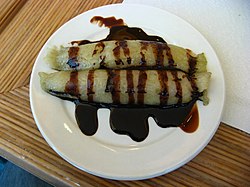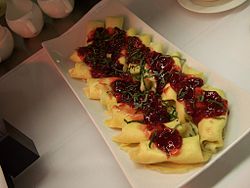

A condiment is a supplemental food (such as a sauce or powder) that is added to some foods to impart a particular flavor, enhance their flavor, [1] or, in some cultures, to complement the dish, but that cannot stand alone as a dish. The term condiment originally described pickled or preserved foods, but now includes a great variety of flavorings. [2] Many diverse condiments exist in various countries, regions and cultures. This list includes notable worldwide condiments.
Contents
- Condiments
- By country
- Australia
- Azerbaijan
- Bangladesh
- Belgium
- Canada
- Chile
- China
- France
- Georgia
- Germany
- Ghana
- Greece
- India
- Italy
- Indonesia
- Iran
- Japan
- Korea
- Lebanon
- Malaysia
- Mexico
- Norway
- Pakistan
- Palestine
- Philippines
- Russia
- Spain
- Sweden
- Switzerland
- Taiwan
- Thailand
- Trinidad and Tobago
- United Kingdom
- United States
- Vietnam
- See also
- List articles
- References
- External links




































